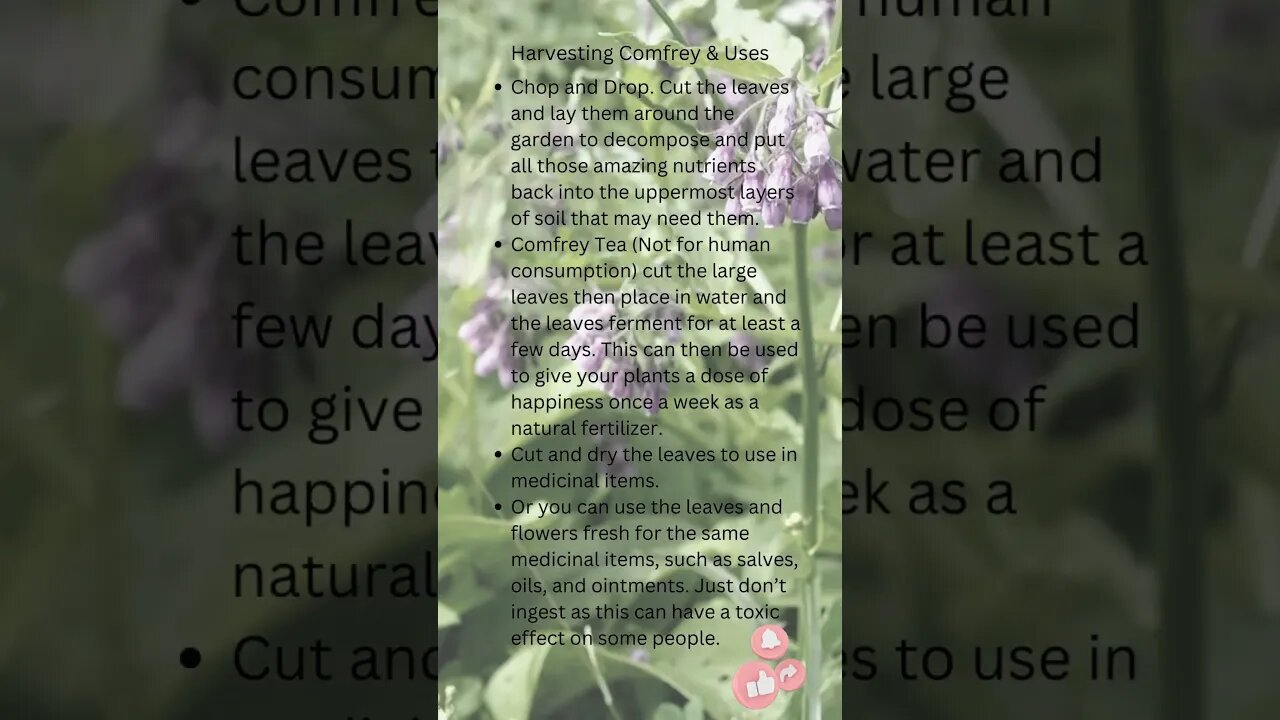Premium Only Content

🌿Comfrey Harvesting & Using🌿 #shorts #gardening #homesteading
Link to full Video: https://youtu.be/zpjgSXQFBgk
Website: www.bleighve.com Instagram: https://www.instagram.com/bleighvehomestead/ Rumble: https://rumble.com/account/content?type=all TikTok: https://www.tiktok.com/@bleighve?lang=en
Comfrey is a plant that has been used for centuries for its medicinal properties. It is native to Europe and Asia, but has been naturalized in many other parts of the world. The plant has a long history of use in traditional medicine, and was even mentioned in the Ebers Papyrus, an ancient Egyptian medical text.
In mythology, comfrey is associated with the Greek goddess Aphrodite. It is said that Aphrodite used comfrey to heal the wounds of her lover, Adonis. Comfrey is also said to have been used by the Vikings to heal wounds and bruises.
In the Middle Ages, comfrey was used to treat a variety of ailments, including arthritis, rheumatism, and broken bones. It was also used as a topical treatment for burns and wounds. Comfrey was even used to make a type of beer!
In the 19th century, comfrey was one of the most popular medicinal herbs in the world. It was used to treat a wide variety of conditions, including anemia, digestive problems, and kidney stones. Comfrey was also used to make a type of poultice that was applied to wounds and bruises.
In the 20th century, comfrey was still used for medicinal purposes, but its popularity began to decline. This was due to concerns about the safety of comfrey. Some studies have shown that comfrey can be toxic to the liver, especially when taken internally. As a result, comfrey is no longer recommended for internal use.
Today, comfrey is still used topically for its healing properties. It is also used as a fertilizer and a compost activator. Comfrey is a versatile plant with a long history of use. It is a valuable addition to any garden or home apothecary.
-
 5:48:40
5:48:40
Dr Disrespect
16 hours ago🔴LIVE - DR DISRESPECT - THE SHOTTY BOYS - WARZONE, PUBG, FORTNITE
222K43 -
 2:12:50
2:12:50
Adam Carolla
17 hours agoDouble Murder Convict to be executed by Firing Squad + Comedian Elon Gold + Comedian Carol Leifer
85.9K17 -
 46:08
46:08
Kimberly Guilfoyle
13 hours agoBad Day to be a Bad Guy: FBI Taking Down World’s Worst Criminals, Live with John Nantz | Ep.203
180K65 -
 DVR
DVR
Redacted News
12 hours agoWhat's REALLY going on in Syria? | Redacted with Natali Morris
186K132 -
 54:18
54:18
Candace Show Podcast
12 hours agoHarvey Speaks: Jessica Mann & The Five Year Affair | Ep 3
199K86 -
 56:53
56:53
Grant Stinchfield
11 hours ago $9.13 earnedFreeze Spending & Kick the Can Down the Road... Why Republicans Should do Just That!
106K16 -
 56:48
56:48
VSiNLive
11 hours agoFollow the Money with Mitch Moss & Pauly Howard | Hour 1
82.8K1 -
 3:28:27
3:28:27
Barry Cunningham
12 hours agoTRUMP DAILY BRIEFING: INTERNET UNDER ATTACK! X & RUMBLE DOWN! EXECUTIVE ORDER SIGNING!
100K60 -
 5:53:56
5:53:56
Scammer Payback
15 hours agoCalling Scammers Live
86.6K6 -
 1:36:15
1:36:15
In The Litter Box w/ Jewels & Catturd
1 day agoABOLISH NGOs | In the Litter Box w/ Jewels & Catturd – Ep. 758 – 3/10/2025
104K64